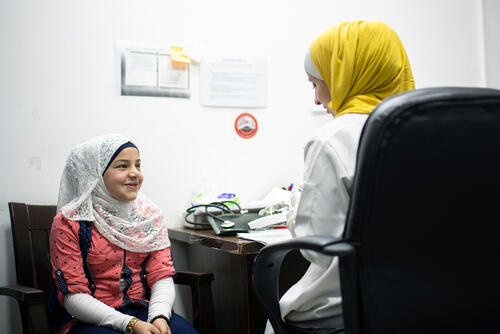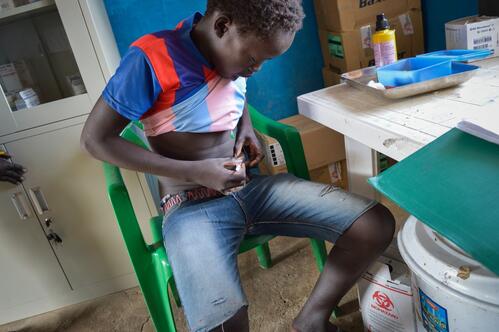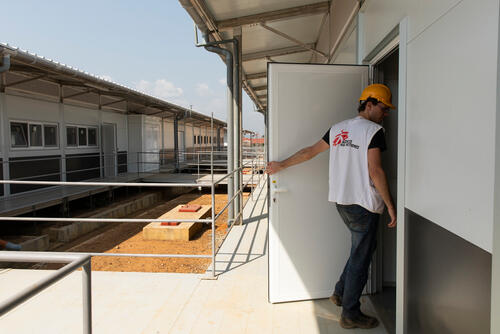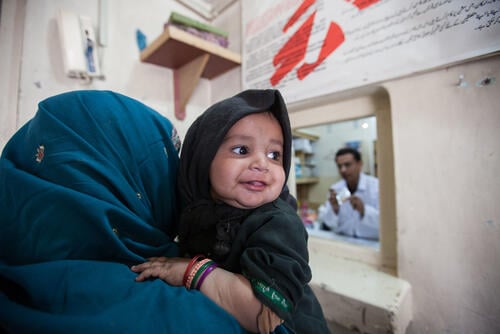While children with chronic diseases – such as heart disease, diabetes, asthma, and epilepsy – are not the majority of MSF's paediatric patients, the needs of these children equally need attention and treatment. Deputy Medical Director Myrto Schaefer explains in this interview some of the diseases our teams see in children in the contexts we work in, and the challenges we face in trying to treat these kids, often in areas of conflict.
What are paediatric non-communicable diseases (NCDs)?
According to the World Health Organization (WHO) an estimated 7 out of 10 deaths worldwide<a href:https://www.who.int/news-room/fact-sheets/detail/noncommunicable-diseases>World Health Organization</a href> are due to non-communicable diseases (NCD), with over 80 per cent of them occurring in low- and middle-income countries. Although ‘only’ four per cent of deaths will occur in people under the age of 30, the majority of deaths in adults are linked to conditions or behaviours in childhood or adolescence, such as smoking, lack of exercise, poor nutrition or heavy drinking.
Meanwhile, there are chronic diseases that occur in childhood and affect the well-being and the lives of children. Diseases such as rheumatic heart disease, congenital heart disease, type 1 diabetes, asthma; specific cancers such as leukaemia and lymphomas; epilepsy; and diseases of the blood such as Thalassaemia or Sickle Cell Disease. In addition to that, 10-20 per cent of children and adolescents experience some sort of mental disorder.
The term ‘non-communicable diseases’ is a little bit misleading because it suggests that they have no infectious origin. This may be true for many of the diseases we are talking about, but not for all. When we talk about NCDs, very often we mean chronic diseases, irrespective of the origin. They are characterised by their duration.

Why is the topic of paediatric non-communicable diseases emerging now in the context of humanitarian response?
In developing countries, the big challenge with chronic diseases is that we are working in contexts where health systems are often not equipped to deal with them. Particularly in paediatrics, often health systems are so overwhelmed with acute diseases like malaria, respiratory infections or diarrhoea, and already struggle to cope with that. There are often no models to respond to children with chronic diseases in such contexts. This challenge was already brought to light when we trying to respond to kids living with HIV, so it is not new.
Without a healthcare response, chronic disease still exists but is just less visible.
In an emergency, once again, the needs often seem overwhelming, and MSF must first work to avoid death and suffering caused directly by the emergency. But very quickly we also have to assess what the population wants and what their general health needs are beyond the emergency. This includes chronic disease care and continuity of care, in some instances care that was available prior to the emergency. When we started working with Syrian refugees in Lebanon, for example, we quickly released that chronic disease care constituted a big part of what this population really needed.
In conflicts and emergencies, when the priority seems to be to save lives, how can we integrate paediatric non-communicable diseases into our humanitarian response?
It’s true that when deciding where to spend our time, energy and money, there are competing priorities with those diseases that kill immediately. For instance, in South Sudan we are currently treating 48 children with diabetes but in South Sudan what kills exponentially more children is not diabetes but malaria, respiratory diseases, diarrhoea, etcetera. Compared to that, the numbers of diabetes deaths are miniscule, even if every child who presents with diabetes has a 100 per cent certainty of dying if not treated. So why should we invest a lot in diabetes?
In fact, you could argue that diabetes and other chronic diseases affecting children are neglected diseases. So, in this project in South Sudan for example, the big discussion has been: should we treat children with diabetes if we do not know what care they will receive in the long term?
Should we let the child who comes in a diabetic coma die although we have insulin even if we don’t know how to provide quality long-term care? The child might suffer from complications such as blindness in a few years— diabetes has many complications if you don’t control it correctly. Or, should we give the child the chance to survive and invest resources in finding improved models of care and maybe one day she or he will be lucky to have access to better care?
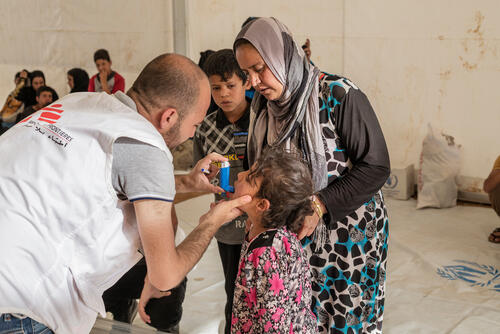
What are the challenges to including paediatric non-communicable disease care in MSF projects?
As mentioned above we don’t see many models of functional integrated chronic care in developing countries, including the necessary continuum of care, and this is particularly lacking in poor, rural settings. Often there is no disease awareness regarding chronic disease, neither by the patient or the caregiver, nor by the health worker. Or by the time the disease is obvious it is often well-progressed and there is no knowledge of how to treat it. Most health workers in these countries have never been trained on any chronic diseases.
There is also a big problem with access to adequate medication. Treating children with chronic disease means availability of specific medication according to the age and adapted to climatic conditions (such as heat); there is a question of cost, and of course of quality and sustainable supply.
Referral to higher levels of care is often not feasible or affordable, and it is questionable whether that care would be helpful at all.
In general, due to a lack of experience and expertise on the ground, mounting a feasible response often requires additional resources. So we need to be inventive and think about how we can equip our teams to respond efficiently to those diseases, but in a “simplified” way. In high-resource settings we usually have a lot of specialists and although drugs might be expensive, they are usually available and the necessary support systems, such as education, are there. In MSF there is no way that we can send all those specialists to our projects, so we need to find good models of care with simplified protocols and support through other channels, such as telemedicine.
In addition, to successfully address chronic diseases, the patient and/or caregiver need to understand and develop ownership of how to deal with the disease. This requires patient education which has to be age- and patient-adapted. Overall, MSF is still very far from this.
If we decide to get further involved, we can have a big role to play here: identifying the gaps, finding better-adapted solutions and pushing for them.
Why is MSF discussing treating paediatric non-communicable diseases now?
For sure, children with non-communicable or chronic diseases are not the majority of our patients, but they do exist and there are a number of chronic conditions we could potentially address. We have started addressing some of these, such as Thalassaemia or epilepsy for example, but we still have a very long way to go. And we almost never talk about these patients and their needs. The last time we talked about chronic diseases in children was when addressing HIV. The topic of chronic diseases is too quickly put into the “too hard” basket. But we are well-placed to take up this challenge. Of course it will need investment and commitment. We have a lot to learn, from our patients and their families, from health workers, and from others working in this field.



